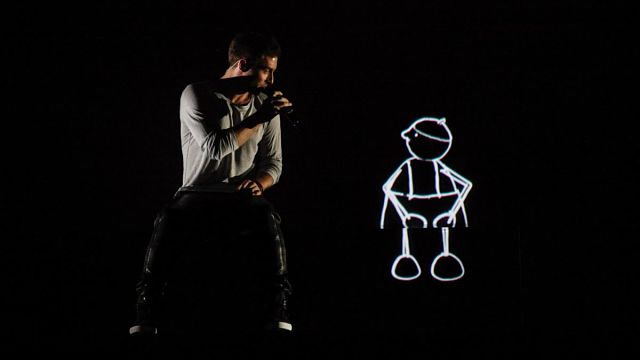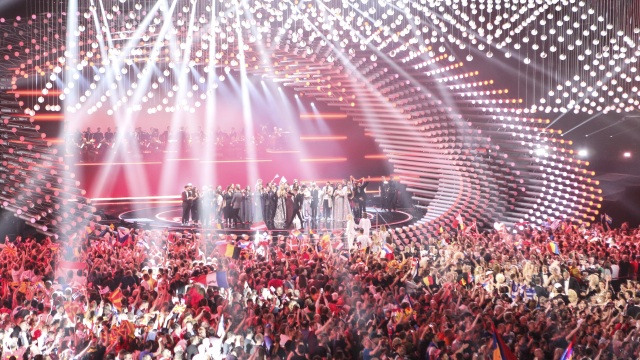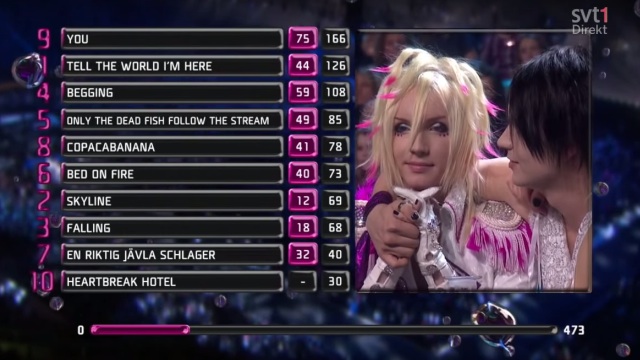This morning the EBU has announced a change to the voting system of the Eurovision Song Contest.
There’s a significant visible change in terms of how votes will be presented, but also a subtle change in how the 50/50 split of public and jury votes will be tallied up. The former will increase the excitement in the Contest (and hopefully balance the change with tradition), while the latter will increase the competitive element at the risk of increasing the power of diaspora voting.
The changes are not without precedent and they will feel unusual come May 12th in Stockholm, but they should allow a rejuvenated Song Contest to meet the demands of modern television events and respect its highly connected audience.
What’s Actually Changing?
Eurovision.tv lays out the changes in this blog post, while SVT have released a video of Christer Björkman and Martin Österdahl explaining the process.
In broad strokes, after the songs are performed in the Grand Final, only the jury votes will be presented by the spokespersons from around the continent. This will be the traditional points structure of ’12, 10, 8, 7, 6, 5, 4, 3, 2, 1′, and means the Song Contest retains the traditional ‘douze points‘ introduced (by SVT) in 1975.
Here’s the twist. Because this is only the jury score, it makes up half of the total points available. The public results from 43 countries will be added tougher, and announced en masse in a new second round of voting, starting with the lowest scoring country in the public vote, right through to the highest scoring country at the end. If San Marino has a total of 9 points once all 43 public results are added together, the show’s host will simply announce “San Marino… nine points!”.

Runaways will still need to wait until the end of the night (Photo: Thomas Hanses/EBU)
This should leave the winner in doubt until the very last score is announced. Even with a runaway victory nobody will be quite sure how many points each country will gain, leaving the winner in doubt until the last score is announced. That ratchets up the tension, creates more anticipation, and (hopefully) a more exciting show… through a simple change in presentation that has been used for a number of years in Melodifestivalen.
It’s also about addressing an issue with the structure of the Song Contest. Every modern TV show needs a beginning, a middle, and an end. Eurovision has a beginning (the songs), a middle (the physical act of voting and the interval act), and an end (the voting). Since the expansion of the Contest in the 21st century, the end of the Song Contest currently lacks a strong punch.
With the announced changes, tradition is maintained but a cliffhanger ending is assured.
More Voting Speeds Up The Show
Once voting lines are closed, the EBU and its voting partner require time to validate the public vote. This usually takes thirty to forty minutes, which demands an extensive interval act to cover the process. While I expect an SVT act to perform after the voting closes, the presentation of the jury votes – which are collected the night before – can begin while the validation process is still under way. Right there is the ability to save anything up to 45 minutes of running time.
In theory a tight timetable could allow Eurovision to run for just 3 hours and 15 minutes, but if we add in a bit of a safety net (and some extra time to add in a few more ‘heartbeats’ of atmospheric music as the public votes are announced) the proposed 3 hours 30 minutes running time should be easily achievable for the first time in four years.
There May Be Trouble Ahead
There are some dangers here around presentation. Although everyone can practice this until May 12th, SVT need to run this live to see where next year’s host broadcaster will need to improve. Going though each country to announce their public vote in round two could mean the cameras will be focused on a performer who is ‘going to lose’ for most of the 26 scores. Eurovision must not turn into a cruel piece of reality TV – imagine the reaction of Anna Bergendahl and the SVT team magnified twenty five times in under an hour?

Anna Bergendahl before the fall (Giel Domen/EBU)
I’m also not convinced that the running order to reveal the scores in round two should be based on the public scores. This is a finely balanced point, and I’m happy to hear the EBU/SVT argument for its decision, but I would much prefer to see the final jury scores used and have the sequence run from lowest to highest of those scores. Juries and public do not always agree, so giving away ‘who’s next in the public ranking’ takes away some of the unpredictability.
A lot is already being changed for those at home. Change too much, and it’s going to be harder to explain to viewers. Using the existing order on-screen from round one is an easier sell to the public at home (who are likely going to have a drink or two in them by that point).
And that leads me to my final big concern. The commentators now have a lot more work to do, and need to sell this to the audience at home. A flippant “no, I don’t understand either” followed by a little Irish giggle simply will not do. This new presentation demands buy-in from all the broadcasters. The Eurovision Song Contest gets one chance to make this right, and I would hate to see this chance sacrificed for a weak comedy punchline.
The Subtle Change In Scoring
There’s something deeper going on here that is worth examining. The changes empower voters at home and magnify their chance to have an impact on the results.
The jury votes and public votes from a country are not going to be combined. This year’s Eurovision Song Contest is effectively two Contests in one with the juries scoring all the songs from one to twelve points in ‘the first Contest’, and the public scoring the same songs from one to twelve points for ‘the second Contest’. The scores are then aggregated together, like a two-legged football game, to give the final score and the winner.

Come together on the streets of Stockholm (Image: SVT)
In previous years, a strong performance in the public voting could be negated by a weak jury vote. The obvious example here is Poland’s 2014 result in the United Kingdom, which saw ‘My Słowianie‘ top the UK public vote but finish 25th in the UK Jury rankings, giving a combined result of 11th place. Which scored no points. Under the 2016 system, Poland would score nul points in the Jury vote from the UK in round one of the voting, and 12 points from the public vote in round two.
Of course scores are effectively doubled under this system with a maximum of 24 points available per country, so Poland’s 12 under the 2016 rules is effectively a 6 under the previous rules. Nevertheless this is a positive change for the viewing public. A jury can no longer override public opinion. It can suggest what it thinks is a better song, it can reward its favourites, but if the public vote says ‘X’ then ‘X’ will score points.
Think of the public and jury votes like two cars. Previously they were attached by an elastic band… if one of them screamed ahead the other could pull it back when the votes were combined. The car with the jury had five brakes that any single juror could use, giving them a huge amount of power to hold back the public’s choice. That elastic band has been cut and now there is no connection between the cars. The jury car can put the brakes down a single song as much as they like, the public’s car can hit the accelerator with no inhibitions.

The best car picture we could find… (image: Ewan Spence)
Here Come The Problems
It’s not all sweetness, this ‘double-score’ system has issues, especially at the edges.
Countries which previously were ‘100% jury’ because the televote failed to reach the threshold or are simply unworkable (such as San Marino) now have an unwieldy system of a televote being made by committee (“a substitute result is calculated by the audience result of a pre-selected group of countries.”). That process is unclear but I can see one potential flaw already; with countries unable to vote for themselves, any country who’s vote is used to create a composite vote will be disadvantaged.
Arguably this may only amount to a handful of points, and it’s been a long time since a victory was that close, but qualification from the Semi Finals is another matter.
Looking at the Semi Final results from 2015, although the same ten countries qualified from the first Semi Final, Hungary gains two places to reach 8th instead of 10th. Outside of the Top Ten Moldova and Belarus, and Denmark and the Netherlands both exchanged places.
It gets more interesting in the second Semi Final. Malta now jumps into ninth place and would have qualified, Montenegro is pushed down to tenth, and Azerbaijan would be pushed into eleventh place and would be eliminated under the 2016 scoring system… but only if we assume the 100% Jury vote from San Marino and Montenegro are duplicated in the televote column. If that is the case Malta scores 17 from these two juries and similarly Azerbaijan scores 7. (We’ve ignored the Azeris’ 100% televote to focus on the impact of the two smaller countries).
Malta on 116, Montenegro on 105, Azerbaijan on 104. A spread of 12 points… with a maximum 24 points decided by ‘The EBU Committee For Substitute Results.’ It’s not hard to imagine that an EBU decision will materially impact on the semi-final qualifiers this year – especially as San Marino and Montenegro are both in Semi Final 1 which means 116 points will need to be allocated in round 2.
And then there’s the diaspora. Juries were reintroduced to the Eurovision Song Contest in 2009 because of the impact of diaspora voting. Now that the relationship between the jury and the public vote has been cut, the diaspora vote will be more noticeable in the second round of voting – which is based 100% on public voting.
Again, because this is impacting on just half of the aggregated score it may amount to a handful of points, and is unlikely to change the winner of the Contest. But the lower places on the score table, and certainly the qualifiers from the two Semi Finals, will feel this impact. Expect countries with strong diaspora or recognised regional voting to have higher scores in the second round of voting.
Are these issues worth the reputational risk to the Contest so that the broadcast show can be more exciting and in line with modern television? I hope so.

We still end at the same place on the stage (image: EBU/Thomas Hanses)
Time To Stop Sending Safe Songs
Personally, these changes deliver a huge amount of benefits to the Contest. There are some issues at the edges that I think need to be thought through, but Eurovision 2016 should be a more exciting experience for the TV audience, it is more transparent in the Jury and Public scoring, and it empowers the audience by fixing a number of issues where viewer’s votes could be ignored or overruled.
I’ve always been a strong proponent of the Eurovision Song Contest putting the competitive elements ahead of changes made purely for the sake of entertainment (the producer-led running order will remain a good-natured point of disagreement between myself and Jon Ola Sand for a very long time). But these are changes I can get behind. The changes to presentation are just that… changes to presentation. The underlying scoring system remains the same (although we are going to get a record high-score from this year’s winner).

Speaking of close and exciting ending (image: SVT Direkt)
It’s the changes to the competitive side that I like. Since the reintroduction of the juries the maths behind the ‘combination’ of the two sides has given more power to the jurors to drag down a contentious song. That’s no longer the case.
This system offers some comfort to ‘the traditional jury song’ that looks to appeal to one side of the voting. But it also helps diaspora focused or genre songs qualify because without the drag effect, a strong public vote is just as useful. A bizarre example here is Albania 2014, which would just miss out on qualification in 11th place, compared to a very lowly 15th it actually received. Surprise surprise, it was 9th in the jury vote.
Again, this is a matter of a handful of points, and the effect is mostly seen mid-table. The top of the leaderboard still is dominated by songs that command huge support from both jury and public. We’ll have a full analysis in a later article.
Final Thoughts
The headline on the official site is ‘Eurovision Song Contest voting undergoes massive change‘. I would disagree with that assessment. The presentation has changed, but the presentation has constantly changed since the Contest first started in 1956, for the EBU to say that this is a massive change perhaps reflects their attitude that Eurovision should be seen first as an entertainment show, and a musical Contest second. To me it is not a massive change.
The voting has received a subtle tweak to emphasis the dual nature of the Contest – jury and public voting are two separate parts of the same Song Contest. The changes enhance the competitive elements of the Song Contest and allow them to be magnified by the presentation, and rightly so. It should be the competitive element that drives the entertainment, not the other way around.
The two sides of Eurovision – the Contest and the Show – have to work together to create the best show possible. Neither should be subservient to the other. There has been a bias towards entertainment in recent years that has devalued the competitive side. Thankfully today’s changes have a positive impact on both sides of the equation. Now to see if they can #ComeTogether on the night.










Do you have a Bat phone to Jon Ola Sand, Ewan? Impressively swift and thorough explanation of the implications of this change.
Nice analogies used there Ewan – that made it a bit more understandable!
The main benefit will be a country getting points for a more ‘unusual’ performance that appeals to public but not jury – no longer will we have five juror’s ‘free votes’ totally overruling the ‘money spent’ votes of the public (I wonder if there has been some EU rumblings ‘off the record’ about last year’s result with the public’s SMS winner not winning due to this?). They can still dent the popularity but cannot negate it.
I suspect there will be some issues but there always is with new systems – the 2017 hosts will be the ultimate beneficiaries…
“A flippant “no, I don’t understand either” followed by a little Irish giggle simply will not do” – nice nod to a recently deceased legend there, I can just imagine him saying it too!
“I would hate to see this chance sacrificed for a weak comedy punchline.”
Don’t worry, with SVT in charge, it’s not going to be a weak comedy punchline. It’ll be a whole weak comedy running theme, then followed by the weak punchline.
Ignoring the whole “EBU get to make up whatever votes they like” part, which troubles me a huge amount, I’m actually quite happy with these changes. It’s good that they’ve found a sensible way to stop the juries and public from cancelling each other out, and I do like the way they can hold back the winner announcement until the last minute, so we don’t have Petra trying to end the show with 4 countries still to reveal their votes. Let’s hope the the new voting works as well on screen as it has the potential to on paper.
I am concerned by the rampant “Melodifestification” of the show everytime Martin and Christer take the reins. Combined with the other change of getting the spokesperson to only reveal the 12 point score, this is surely taking us further down the slippery slope of removing the second half of the show altogether. What changes will they get to push through next? Super finals? Unlimited people on stage (as long as they’re not actually really singing)? Miming?
Hi Ewan
“I’m also not convinced that the running order to reveal the scores in round two should be based on the public scores. This is a finely balanced point, and I’m happy to hear the EBU/SVT argument for its decision, but I would much prefer to see the final jury scores used and have the sequence run from lowest to highest of those scores. Juries and public do not always agree, so giving away ‘who’s next in the public ranking’ takes away some of the unpredictability.”
I didn’t understand this bit, can you clarify?
Agree with you on everything though – probably a positive step though a couple of worries. I reckon they won’t announce all 26 songs in reverse order, that’d be too humilating. They’ll probably show the bottom 10 or so all at once just on screen, rather than saying “Austria, 0 points”
The idea of fabricated votes being the difference between winning and qualifying is also very worrying, but I don’t know if there is a 100% satisfactory solution to this.
My other small worry is that the long process of revealing the jury votes will feel less important. Like, who cares if a country gets 8 or 12 points from any one country, or country X is 40 points ahead of 2nd place, when the televoting can change everything. Sure, that bit at the end then is more exciting, but it might make the earlier bit feel, not pointless, but less important than it is now.
Could this change make the winner seem less legitimate?
For example, I know a lot of people weren’t happy with Azerbaijan winning in 2011, but wouldn’t it have been all the more annoying had they never once looked like taking the lead throughout the jury voting, and only shockingly overturning that lead at the last moment? Great TV yes, but it might just make people question whether it was a fair result, because they had been trailing all night.
And of course if the actual winner only comes 2nd, 3rd or worse in the televote, doesn’t that also put a downer on their win a little? I know we found out pretty quickly after the final that Sweden hadn’t won the televote last year, but maybe it didn’t feel as wrong psychologically because we didn’t know that until after the show, and we saw them take the lead from Russia gradually, not suddenly overturn a massive deficit.
A good article, one thought, though:
“It should be the competitive element that drives the entertainment”
And the songs, I would add…
It can be better if the televoting awards the top 26 instead of top 10. This way, the dispora votes will not affect the ‘real votes’ , especially in the semifinal.